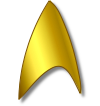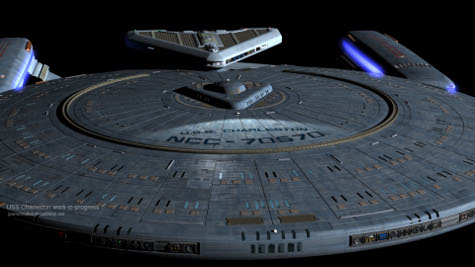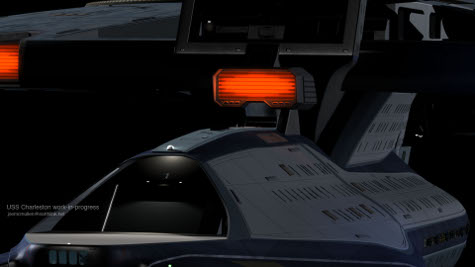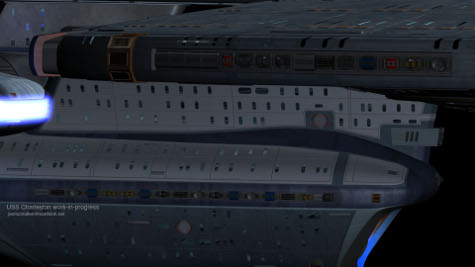
Ship Schematics
C h a r l e s t o n C l a s s
 [USS Charleston (first ship of its class); design and images by Joe McMullen.]
[USS Charleston (first ship of its class); design and images by Joe McMullen.]

Ship Specifications
General Data
Ship Name: USS Excelsior
Registry: NX-2000-C
Class: Charleston
Type: Battle/Exploration Cruiser
Built: Utopia Planitia Shipyard, Mars
Launched: Stardate 20911.01
Commissioned: Stardate 20911.01
Technical Data:
Dimensions | Crew Capacity | Transporters | Computer System | Accessory Vessels | Propulsion | Warp Drive
Weapons | Defensive Systems | Separation Mode | Sensors
Deck-by-Deck Chart: Saucer Section | Stardrive Section
Technical Data
Dimensions
Length: 550 meters
Width: 342 meters
Height: 125 meters
Mass: 691, 943 metric tons
Crew Capacity
Officers: 125
Enlisted: 550
Other: 3000 max evacuation capacity
Transporters
Personal: 6
Cargo: 10
Emergency: 55
Computer System
V-109-A Bio-Neutral Duotronics Computer Core System
Accessory Vessels
- 3 Runabouts (Formerly Type-9B Shuttlecraft)
- USS Amur
- USS Belaya
- USS Cimarron
2 Type-11 Shuttlecraft
3 Type-12 Shuttlecraft
5 Type-9A Shuttlecraft
8 Type-6 Shuttlecraft
Propulsion
Type-57 Slush Deuterium Engine with Neutrino Accelerators
Maximum Impulse Speed: 0.770c
Standard Impulse Cruising Speed: 0.25c
Warp Drive
Ceries F-Type Matter/Antimatter Engine with variable geometry warp nacelles
Standard Cruising Speed: Warp 6.3
Maximum Cruising Speed: Warp 9.3
Maximum Emergency Speed: Warp 9.7 for 12 hours
Weapons
12 Type-XII-C Phaser Arrays, rated at 22 gigajoules, and equipped with computer-controlled multi-fire
-
- Saucer Section:
- Four dorsal
- Two ventral
- Two aft
-
- Stardrive Section:
- One at the head of the stardrive section (where the saucer and stardrive sections connect)
- One on the bottom of the ship (beneath the main deflector dish)
- One on the starboard nacelle-connector
- One on the port nacelle-connector
- Four Rapid-Fire Pulse Photon Torpedo Launchers
- Two fore stardrive
- One aft stardrive
- One fore saucer
- 200 Mark-X M/A Photon Torpedoes (30 gigajoule yield)
Three Rapid Fire Quantum Torpedo Launchers
- Two fore
- One aft
250 Mark-XI M+/A+ Quantum Torpedoes (50 gigajoule yield)
Defensive Systems
- Enhanced Defensive Shielding Package
- Eight Separate Shield Generators on continuous cycle, with Advanced Multi-phasic Subroutine (Four Saucer, Four Stardrive)
- Enhanced Plutonium Plating
- Tri-layered Ablative Armor
- Type-8 Standard Shielding System
Separation Mode
The Excelsior has the ability to separate its saucer and stardrive modules in emergencies.
Sensors
Primary SWAC array (cross-matrixed)
- Complete primary LRS package:
- Wide-angle active electromagnetic scanners
- Narrow-angle active electromagnetic scanners
- Gamma ray telescope, 5 meter lens
- Electromagnetic flux sensor, variable frequency
- Custom anomalous reading sensor, calibrated to both temporal and physical anomalies
- Lifeform analysis instrument package with custom zoological database
- Parametric subspace field stress sensor, quad-variable
- Broad-spectrum imaging array, tested to frequency extremes
- Full spectrum analytical capabilities
- Complete primary SRS package
- Ship sensors, cooperative with tactical arrays
- Interior scan package, complete with personnel database
- New diagnostic subroutines, using engineering computer data for to-the-instant damage reporting
- Additional anomalous scan package
Secondary LRS and SRS packages, used primarily for flight and battle
Tertiary lateral A/P (astronomical/planetary) sensors for emergency use
Complete astrophysical database
Full stellar cartography suite
Deck-by-Deck Chart
(Please note that Charleston-class vessels carry an upper sensor pylon akin to that seen on the Nebula-class vessel. This pylon comprises 6 additional decks, denoted "Pylon 1" through "Pylon 6" -- but they contain little more than maintenance passageways and interfaces for changing the sensor package.)
Saucer Section:
- Deck 1 - Bridge (dedication plaque), Captain's Ready Room, Commander's Ready Room, Observation Lounge (view)
- Deck 2 - Stellar Cartography, Briefing Room, Captain's Quarters, Captain's Mess (view)
- Deck 3 - Holodeck 2, Living Quarters, Chief Science Officer's Quarters, Guest Quarters, State Room (view)
- Deck 4 - Transporter Rooms 1 and 2, Living Quarters, Mess Hall (view)
- Deck 5 - Main Shuttlebay, Dorsal Phaser Array (view)
- Deck 6 - Holodeck 1, Gymnasium, Living Quarters, Mess Hall (view)
- Deck 7 - Main Security Offices, Brig, Security Chief's Office (view)
- Deck 8 - Main Sickbay, Medical Labs, Gymnasium, CMO's Office (view)
- Deck 9 - First Officer's Quarters, Arboretum, Main Science Labs, Science Chief's Office (view)
- Deck 10 - Main Weapons Locker, Ventral Phaser Array, Living Quarters, Mess Hall (view)
- Deck 11 - Saucer Engineering, Senior Officers' Quarters, Saucer Impulse Engines (view)
- Deck 12 - Shuttlebay 2, 12-Forward Lounge, Transporter Rooms 3 and 4, Chief Engineer's Quarters, Living Quarters (view)
- Deck 13 - Cargo Bay 2, Living Quarters, Mess Hall (view)
- Deck 14 - Shuttle storage, Weapons Locker 2 (view)
- Deck 15 - Environmental Controls, Living Quarters (view)
- Deck 16 - Separation Deck
(For images of the general layout of living quarters, see LQ#1, LQ#2, and LQ#3.)
Stardrive Section:
- Deck 16 - Separation Deck, Main Stardrive Phaser Array, Battle Bridge
- Deck 17 - Living Quarters, Mess Hall, Transporter Rooms 5 and 6
- Deck 18 - Photon Torpedo Storage, Quantum Torpedo Storage, Main Impulse Engines
- Deck 19 - Secondary Science Labs, Astrophysics
- Deck 20 - Holodeck 3, Holodeck 4, Cargo Bay, Living Quarters, Mess Hall
- Deck 21 - Weapons Locker 3, Antimatter Storage Pod
- Deck 22 - Main Engineering, Warp Core, Main Equipment Locker, Chief Engineer's Office
- Deck 23 - Matter Storage Pod, Cargo Transporters
- Deck 24 - Main Deflector Dish, Main Deflector Controls
- Deck 25 - Living Quarters, Stardrive Sickbay, Tertiary Science Labs
- Deck 26 - Main Cargo Bay
- Deck 27 - Computer Core, Living Quarters, Mess Hall
- Deck 28 - Emergency Batteries, Living Quarters
- Deck 29 - Deuterium Fuel Storage
- Deck 30 - Supplementary Living Quarters, Mess Hall
- Deck 31 - Anti-Matter Storage Pods
- Deck 32 - Supplementary Living Quarters
- Deck 33 - Deuterium Fuel Storage, Supplementary Living Quarters
- Deck 34 - Deuterium Fuel Storage, Supplementary Living Quarters
- Deck 35 - Deuterium Fuel Storage, Supplementary Living Quarters
- Deck 36 - Warp Nacelle Access Tubes
Contributing, 1999: Commander John Styre, Lt. Commander Mavelle Kivo


